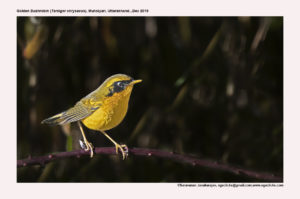
Golden Bush Robin Tarsiger chrysaeus
Etymology:
Nominate:
- Tarsiger : Greek word tarsos- flat of the foot; Latin word ger –bearing
- Chrysaeus : Greek word khruseios golden
Sub-species:
- T.c. whistleri: Named after Hugh Whistler (1889-1943) , British naturalist
Vernacular names: Lepcha: Manzhil-pho
Distribution in India:
- Nominate- Central & East Himalayas from Uttarakhand Eastwards, non-breeding also in Assam hills
- c. whistleri– North India (Uttarakhand)
Description: Size of 14–15 cm; wt. of 12–15 g. The male of nominate race is brownish-olive from crown to back, broad bright orange-yellow supercilium, scapulars, rump to tail side and entire underparts , with blackish mask, wings and centre and tips of tail. The bill is dark above, yellowish below; long legs are olive-yellow. The female is duller and much less variegated, lacks black mask and orange-yellow on scapulars, has smaller and duller yellow supercilium, orange-yellow eyering, upperparts are olive-tinged with golden-brownish, some orange on tail side and buffish-orange underparts. The juvenile is dark brown with buff streaks above and below, tail as adult in male, pattern diffuse in female. Race whistleri is paler above and below than nominate.
Habitat: It breeds in fairly diverse array of highland habitats, occupying open patches with bamboo and shrubbery, second growth and undergrowth within entire fir-dominated coniferous belt up to tree-line, penetrating also bushy and dwarf rhododendron zone, willow stands along streams and bush-free open alpine pastures. It is found in 3000–4600 m in summer ,down to 600 m winter.
Food Habits: It eats insects. It forages on ground or in lower parts of shrubbery; often making short aerial sallies after flying prey.
Breeding habits: They breed in May–Jun. The nest is a compact saucer of moss and grass, lined with hair, wool or feathers, placed in hole in bank or steep slope. They lay a clutch of 3–4, eggs. The nestling period is 14–15 day.